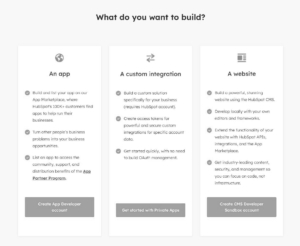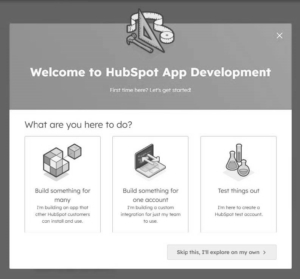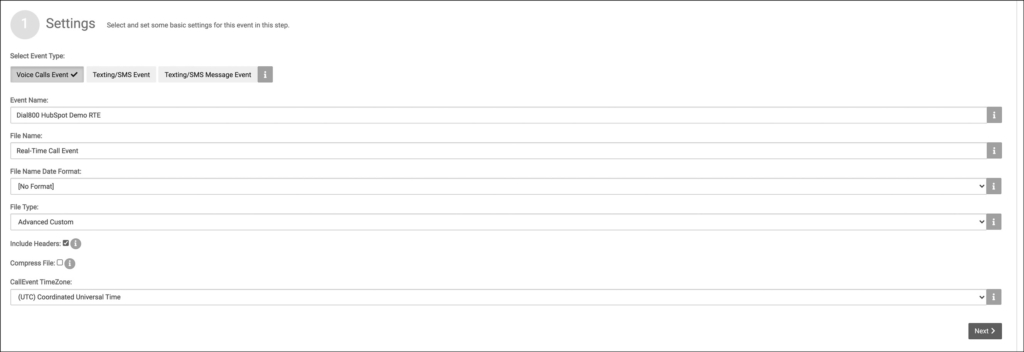This article walks you through the steps for integrating your Dial800 account with HubSpot, using a test account. Dial800’s open API allows for seamless integration of your inbound campaign data into HubSpot so you can view your call tracking and customer data in one spot.
The integration setup process requires you to go between Dial800 and HubSpot frequently, so we recommend you have the sites open in two browser windows to easily toggle between them.
Need to get to a specific step? Jump to:
- Step 1: Creating Your HubSpot Developers Account
- Step 2: Setting Up Your Integration
- Step 3: Creating a Realtime Event for HubSpot Integration
- Step 4: Test Your HubSpot Integration
What is HubSpot & How Does it Help Track Your Data?
HubSpot is a sales, marketing, and CRM software. It can be used to create custom records, create and manage contact lists, schedule and publish social media posts, create landing pages and call to action buttons for your website, and more.
By integrating your HubSpot account with your Dial800 account you can view your call data in one place, easily tie that call data to your existing customer records, and better see more than just your customer’s caller ID with creating your reporting.
Step 1: Creating Your HubSpot Developers Account
If you have an existing HubSpot developer account you can navigate to the HubSpot Developer Home Page, click on Manage Apps and then on the next page click Create App. This will take you to Step 2: Setting Up Your Integration below.
If you need to create a Developer Account, follow these steps:
- Go to https://developers.hubspot.com and click on Create a Developer Account.
- Under the An App option, click the Create App Developer Account button.

- To create your account:
- Verify your email address
- Create a password for your App Developer Account
- Complete the HubSpot Questionnaire
- Give your Developer Account a unique name (for this example, we’ll use “Dial800 Developer test account”)
- Click Create Account
- On the Welcome to HubSpot App Development window, click the option for Skip This, I’ll Explore On My Own.

- Click Create a Test Account.

- Then click Create Developer Test Account.
- Give your developer test account a unique name and click Create.

Step 2: Set Up Your Integration
- Under Account Details in HubSpot, click on the name of your test account.

- In the new window that opens, go to Reporting & Data in the menu and select Integrations.

- Select Private Apps under Integrations. It may take some time for HubSpot to finish creating this account; if you receive an error, please wait a few minutes and then refresh the page to try again.

- Click Create a Private App.
- Under Basic Info, change the name to a descriptive name, upload a logo, and add a description if desired.

- Click on the Scopes tab.
- Search for and select the following scopes:
- oauth (request)
- timeline (request)
- crm.objects.contacts (Read & Write)

- Click Create App.
- Click your account name in the upper right-hand corner, hover over your account, and under All Accounts select the account (the one you created in Step 1: Creating Your HubSpot Developers Account above).

- Click Create an App.

- Under Public App Name, change the name to a descriptive name (for this example, we’ll use “Dial800 RTE HubSpot Integration 1”) and click Save Changes.
- Click the Auth tab.
- Enter [apps-v3.dial800.com/Accuroute/Integrations/Default], without the brackets, into the Redirect URL field.
- Click +Add New Scope under Scopes, and search for and add:
- oauth
- timeline
- crm.objects.contacts.read
- crm.objects.contacts.write

- Click Update.
- Then click Save Changes.
- While keeping the HubSpot window open, open a second browser window or tab and go to your Dial800 dashboard at https://apps-v3.dial800.com.
- Click on the AccuRoute® tab at the top of the screen.
- Click on the Integrations Panel.
- Click the Configure HubSpot button on the HubSpot Panel
- Under Integration Name, enter the same name as your Public App Name on the HubSpot page (for this example, we will use Dial800 RTE HubSpot).
- Go back to your HubSpot browser window or tab, and on the Auth tab click the copy button after Client ID and paste it in the Client ID space on the Dial800 page.
- Go back to the Auth tab on the HubSpot page and under Client Secret, click Show and then Copy, then paste it to the Client Secret space on the Dial800 page.
- Click Authorize – then the HubSpot Accounts Page will open.
- Select your Developer Test Account (created in Step 1: Creating Your HubSpot Developers Account above) and click Choose Account.

- Click Connect App.

- Return to the AccuRoute integration page in Dial800, click on the Manage Integrations tab in the top left – it should now say Authorized under Status for your HubSpot integration.

Step 3: Creating a Realtime Event for HubSpot Integration
- On the Dial800 platform, click AccuRoute
- Select Real Time Events
- Click the Create New Real-Time Event Button
- In the Settings tab:

- Select Voice Calls Event as Event Type
- Enter Event Name
- File Name can be left as is
- File Name Date Format can be left as is
- Change File Type to JSON
- Check Include Headers
- Uncheck Compress File
- Set time zone UTC
- Click Next
- In the Filters tab:

- Enter desired Filters, if any
- Click Next
- In the Options tab:
- Click Advanced
- Add your Template Data Items
- Click Next
- In the Destination Tab:
- Destination Type is Custom Integration
- Select HubSpot Integration (Standard) under Integration
- Check Vendor Integration
- Select Integration Credentials
- Select your Vendor Integration from the drop-down list

- Select your Vendor Integration from the drop-down list
- Click Next to Confirm
- Click Finish
Step 4: Test Your HubSpot Integration
- In your HubSpot account, click Go to My Account
- Click Dial800
- Click Contacts > Contacts
- Make a test call to a number in the Filters, Calls, Target Numbers of the RTE
- Refresh Contacts page
- You should see the call in your HubSpot contacts
Your HubSpot and Dial800 accounts are successfully integrated. If you have any more questions or need help, you can contact Dial800 Customer Care or call 1-800-DIAL800.


 CallView360®
CallView360® AI Analytics
AI Analytics AccuRoute®
AccuRoute® BizCloud
BizCloud RapidRecall®
RapidRecall® Integrations
Integrations